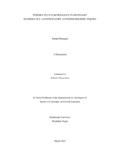
Please use this identifier to cite or link to this item:
https://hdl.handle.net/20.500.14301/297| Title: | INTEGRATING STEAM PEDAGOGY IN SECONDARY MATHEMATICS: A PARTICIPATORY AUTOETHNOGRAPHIC INQUIRY |
| Authors: | Dhungana, Sandip |
| Citation: | Dhungana,S.(2023).Integrating STEAM Pedagogy in Secondary Mathematics: A Participatory Autoethnographic Inquiry |
| Issue Date: | Mar-2023 |
| Department: | DOSE |
| Level: | M.Phil. |
| Program: | MPhil in STEAM Educaiton |
| Abstract: | The STEAM, composed of the aesthetic components of our society and STEM disciplines, has been considered one of the transformative learning approaches. It is observed to be significant in promoting progressive pedagogical activities. The decontextualized nature of mathematics, pedagogical practice, and professional development of teachers was considered the major problems in this study. In finding the solutions to those problems, this study aims for two significant purposes. The first is to critically reflect on my pedagogical practices as a STEAM teacher and an educator. The second is to explore how STEAM pedagogy helps me (as a practitioner researcher, teacher, and teacher educator) and my co-researchers (participant teachers) at the secondary level to improve our pedagogical and professional practices. This study represented my lived experiences as a learner, teacher, educator, and practitioner. I incorporated a participatory autoethnographic design blending Autoethnography and Participatory Action Research (PAR). Knowledge constitutive interest and transformative learning theory guided me both as an autoethnographic inquirer and a PAR researcher. The participants of this study were five teachers at a private school in Kathmandu Valley. This study was based on the narrative stories that I collected from my own experiences as an autoethnographic researcher and the experiences of co-researchers, along with my self-inquiry from the PAR context. The data and information were collected from the field by the three Es (experiencing, enquiring, and examining) models of Mills (2011). The collected narratives were discussed under three major headings: the transformative shift from conventionality to STEAM activism, the journey from mirage to the reality of STEAM pedagogy, and enhancing harmony and transformation with sustainability. The collaborative work in PAR made us aware and critical of what we were practicing in our earlier days. It promoted us to explore a better learning environment for our learners. We critically reflected on those conventional assumptions and practices in which we were following our professional skills. We realized that teachers and students are equally responsible for creating a learning environment inside and outside the classroom. The co-construction of knowledge and mutual understanding in designing the STEAM projects gave us new pedagogical scenarios. This intervention helped us to challenge our one-size-fits-all pedagogy and silent classroom practices. The mathematics-driven intervention helped each of us to find the connection between our disciplinary learning with real-world practices. The notion of a disorienting dilemma and collaborative approach enabled us to clarify each illusion and question. In addition, we (the PAR team) found the importance of affective domains in mathematics classrooms. This intervention made us realize that mathematics is an emotional subject. The fear and boredom of students towards the teacher and subject can be converted into relief and interest. As an insider in this study, I found my role as a meaning-maker and meaning seeker rather analytical. The importance of continuous learning and engagement in self-exploration for both teachers and students was also a major finding of this study. We (the PAR team) realized that transformation is a continuously changing process of one's assumptions and practices. We (the PAR team) found that the STEAM practice can shift the educational paradigm from a teacher-centered to a learner-centered approach; from a knowledge-centered to a skill-centered approach; from a theory centered to a real-life-centered approach; from a positivist to an art-based approach. It is an approach that brings multi-disciplines together to take a holistic picture of education that is beyond the disciplinary aspects. Being a teacher, educator, and researcher, I realized the lack of TPD of progressive pedagogies in our teachers. The notion of the STEAM approach could be a way to establish progressive thoughts and innovative ideas in our teachers. Such contribution can enrich the transformative thoughts and practices in our educational system. The motivation and positive attitudes of the participant teachers towards the STEAM approach after the intervention show its sustainability in their professional skills. Teachers were actively engaged in drawing their classroom environment full of artistic pedagogical practices. Role play, drama, songs, and dance were the major ones. The impact of arts on learners' affective domains has been observed, revealing the intrinsic importance of emotions and motivations in mathematics learning. Through self-reflection, we have become aware of the concepts of learn, unlearn, and re-learn. Implementing new ideas in any context can be challenging, but empowering participants and recognizing their ideas, thoughts, and practices can lead to better approaches. As the government of Nepal has already executed an integrated approach at the early basic level, this study can be utilized to understand the pros and cons of the integrated STEAM approach at the secondary level (Grade X). Such study in the Nepali context can build pillars for innovative pedagogical practices and might make people believe in those practices. Likewise, a secondary teacher can take this study as a reference and be aware of his/her pedagogical practices. The real-world settings and the teachers’ reflections on their practices in implementing STEAM plans can make the readers empathize with their scenes. |
| URI: | https://hdl.handle.net/20.500.14301/297 |
| Appears in Collections: | Dissertation |
Files in This Item:
| File | Description | Size | Format | |
|---|---|---|---|---|
| Final WCC Sandip Dhungana MPhil Edited (1).pdf | 5.18 MB | Adobe PDF |  View/Open |
Items in DSpace are protected by copyright, with all rights reserved, unless otherwise indicated.